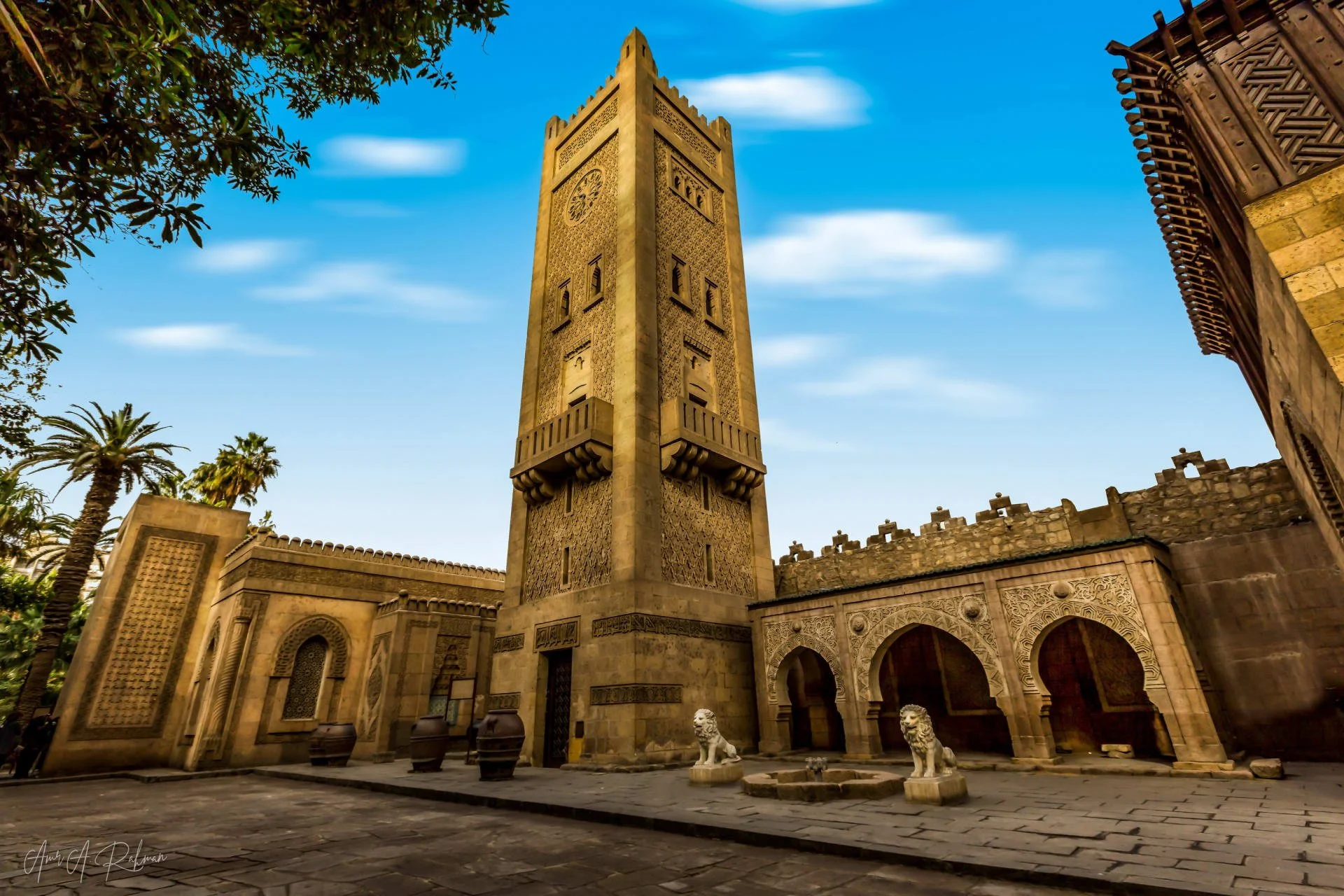Computer-Controlled Cutting
For this project, I recreated a classic mashrabiya design inspired by the intricate wooden latticework found in the Manial Palace. Using a combination of digital design software and traditional geometry principles, I translated the ornate patterns into a laser-cuttable format. The scaled-down version was crafted on cardboard and plywood, maintaining the delicate interwoven aesthetics while exploring the structural capabilities of modern materials. This process highlighted the elegance of Islamic Cairo’s architectural motifs while demonstrating how digital fabrication techniques can preserve and adapt cultural heritage for contemporary applications.
The Background
The Manial Palace, located on Rhoda Island along the Nile in Cairo, stands as a masterpiece of Islamic architectural fusion, blending Fatimid, Mamluk, Ottoman, Andalusian, and Persian styles. Built by Prince Mohamed Ali Tewfik in the early 20th century, the complex features residences, reception halls, a mosque, and lush Persian and English gardens. Designed meticulously by the prince himself, the palace reflects his vision of preserving Islamic arts and architecture while embracing modernity, serving today as a museum that showcases Egypt’s royal heritage and artistic legacy. Its interiors are adorned with rare artifacts, intricate woodwork, and Turkish ceramic tiles, reflecting the opulence of Egypt’s royal past. From its throne room to the private hunting museum, the Manial Palace offers a vivid glimpse into the luxurious lifestyle of the Alawiyya dynasty.
The mashrabiya, a signature element of Islamic architecture, emerged during the Abbasid period in 12th-century Baghdad and reached its pinnacle under the Ottomans. These intricate wooden lattice windows, often enhanced with stained glass, served as tools for passive cooling, privacy, and ventilation in urban homes. Rooted in functional beauty, mashrabiyas reflect cultural values of privacy and sustainability, and their revival in contemporary architecture demonstrates a renewed appreciation for vernacular solutions to environmental challenges.
I decided to make the Mashrabiya from the Manial Palace.
The Works
This project began as a lantern design sourced online, but I found the process lacked the challenge and creative engagement I was seeking. Unsatisfied, I shifted focus to recreating a traditional mashrabiya pattern inspired by the intricate designs of the Manial Palace. By designing and laser-cutting the mashrabiya myself, I transformed the project into a more rewarding exploration of Islamic art and craftsmanship.
Digitalizing the Antiquity
Photograph the Mashrabiya: Capture a high-resolution, front-facing image with proper lighting to avoid distortion.
Set Up Tracing Layer: Create a new layer and use the Pen Tool to manually trace the main patterns.
Use Shape Tools: Add precise geometric elements like circles and squares using the Shape Tool.
Duplicate Patterns: Replicate traced segments across the design using duplication and alignment tools.
Refine Paths: Adjust anchor points and merge shapes for precision using the Direct Selection Tool and Pathfinder.
Apply Symmetry: Use the Reflect Tool to align symmetrical elements for an accurate design.
Prepare for Laser Cutting: Finalize the vector design, set appropriate line weights, and test on materials like cardboard or plywood.
Making the Mashrabiya
Once the mashrabiya design was finalized, it was sent to the laser cutter, where the intricate patterns were precisely cut into cardboard and plywood. The laser cutter’s precision brought the traditional latticework to life, capturing the delicate geometry and fine details of the design. This process not only showcased the elegance of the mashrabiya but also highlighted how modern fabrication techniques can seamlessly recreate historical craftsmanship.
The Challenge: The Intricacy of the Design
The laser cutting process for the mashrabiya design was a demanding endeavor, requiring extended hours due to the scale and intricacy of the project. While the overall size was substantial, it fell just short of being large enough to capture the finer details of the intricate KHSNC logo embedded within the design. This presented a significant challenge, as the laser cutter struggled to execute the delicate patterns at such a small scale, leading to slight imperfections in the cuts. To overcome this, I had to carefully reevaluate the scaling and precision of the vector design, making adjustments to achieve the best possible outcome within the constraints of the equipment. Furthermore, the project required two identical panels, meaning the entire process had to be repeated, doubling the time and effort. These panels were then aligned and assembled in an attempt to recreate the functional, window-like essence of the original mashrabiya, transforming the traditional design into a tangible and modern interpretation while maintaining its historic spirit.
The Final Product
The final mashrabiya design, crafted on cardboard, is a modern reinterpretation of traditional Islamic architectural elements, blending historical aesthetics with the precision of contemporary laser-cutting techniques. The choice of cardboard as the medium added an organic texture to the project, contrasting with the precise geometry of the design. Each panel, cut meticulously, demonstrates the intricate lattice patterns inspired by the Manial Palace, with its blend of Fatimid, Mamluk, and Ottoman influences. Assembling the panels into a three-dimensional structure enhanced the project's depth and function. The layered cardboard construction echoed the architectural intent of the mashrabiya while highlighting its modularity and adaptability. Challenges arose in maintaining the structural integrity of the intricate patterns, particularly the fine details of smaller elements like the KHSNC logo. Despite this, the final panels were robust enough to mimic the traditional window-like function of a mashrabiya, allowing light and shadow to interact dynamically. This project reinterprets a historic art form using modern tools and accessible materials. The juxtaposition of the ancient mashrabiya concept with laser-cut cardboard emphasizes the adaptability of cultural heritage in a contemporary context. The final product is both a tribute to the architectural legacy of Islamic art and an exploration of how traditional craftsmanship can coexist with modern fabrication techniques.













